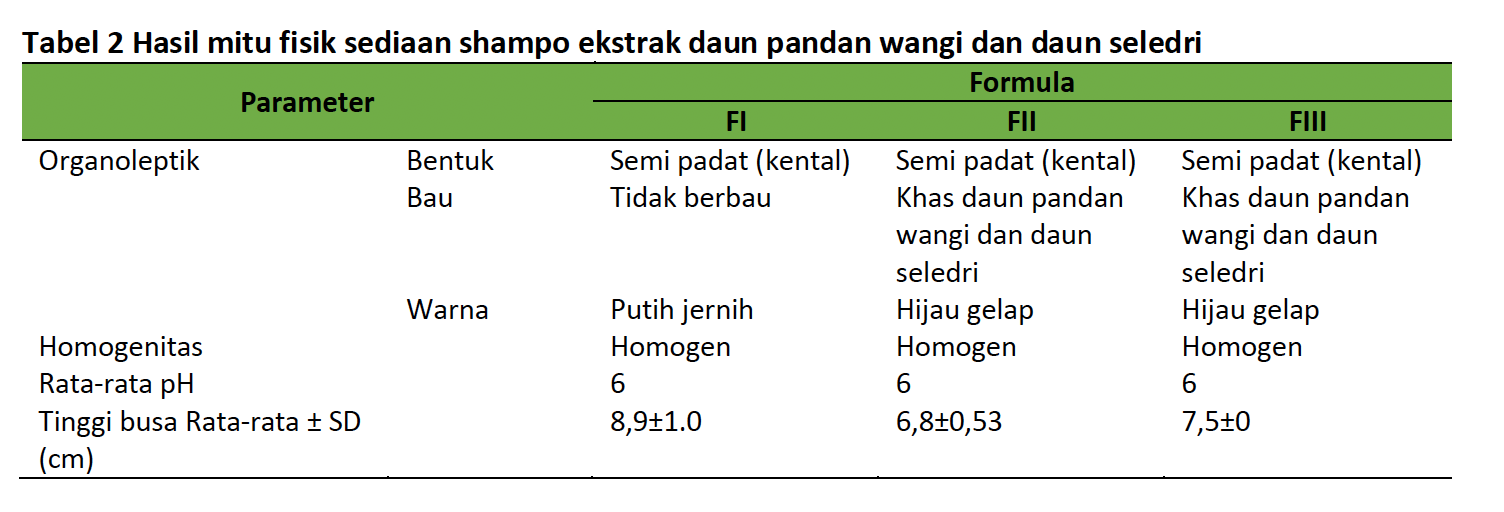Formulation of Combination Shampoo with Extract of Pandan Wangi Leaves (Pandanus amaryllifolius Roxb) and Celery Leaves (Apium graveolens L.) as Antidandruff Against Candida Albicans Fungus
DOI:
https://doi.org/10.36733/usadha.v2i3.7382Keywords:
candida albicans, celery leaves, dandruff, pandan wangi leaves, shampooAbstract
Dandruff is a scalp condition characterized by an anomaly, often caused by the fungus of Candida albicans. The development of safe and effective anti-dandruff shampoo is imperative. Notably, traditional medicine employs pandan wangi and celery leaves, rich in polyphenols, flavonoids, saponins, tannins and alkaloids as potential anti-dandruff agents. The aims of this study was to formulate and evaluate the antifungal activity of a combination shampoo containing extracts form pandan wangi and celery leaves. Antifungal testing was carried out using the diffusion method using paper discs. Three formulations were prepared FI (without extract), FII (10% pandan leaf extract, 20% celery leaf), FIII (20% pandan leaf extract, 10% celery leaf). Antifungal test was evaluated using the paper disc diffusion method, with 2% ketoconazole shampoo as the positive control. Physical quality test demonstrated favorable attributes for pandan wangi and celery leaf extract shampoo, with FII and FIII exhibiting dark green colors whit distinct odors, while FI remained colorless and odorless. Furthermore, all formulations were in semi-solid dosage forms and met pH requirement for scalps (pH 6,) and produced satisfactory foam yields (6,8-8,9 cm). The antifungal activity test revealed FI as the negative control with a 7 mm and 2% ketoconazole shampoo with a 24 mm inhibition zone, while FII and FIII showed no inhibition zone. The combination of pandan wangi and celery leaf extract in shampoo preparation showed no synergic activity to inhibit the growth of Candida albicans fungus. Further investigations and clinical trials are warranted to validate its effectiveness and safety for practical application.
References
Malonda TC, Yamlean PVY, Citraningtyas G. Formulasi sediaan sampo antiketombe ekstrak daun pacar air (Impatiens balsamina L.) dan uji aktivitasnya terhadap jamur Candida albicans ATCC 10231 secara in vitro. 2017;6(2).
[2].
Auliah N, Asri M, SW SR. Formulasi dan uji stabilitas fisik dan kimia sediaan sampo antiketombe ekstrak kulit buah jeruk purut (Citrus hystrix DC). 2015;151:10–17.
[3].
Mardiana GN, Safitri CINH. Formulasi dan uji aktivitas sediaan gel sampo antiketombe ekstrak daun belimbing wuluh (Averrhoa bilimbi L.) terhadap Candida albicans. Semin Nas Pendidik Biol dan Saintek. 2020;630–40.
[4].
Saraswati AR, Putriana NA. Formulasi sampo antiketombe dan anti kutu rambut dari berbagai macam tanaman herbal. Farmaka. 2013;15:248–60.
[5].
Hutauruk H, Yamlean PVY, Wiyono W. Formulasi dan uji aktivitas sabun cair ekstrak etanol herba seledri (Apium graveolens L.) terhadap bakteri Staphylococcus aureus. Pharmacon. 2020;9:73.
[6].
Oktaviani DJ, Widiyastuti S, Maharani DA, Amalia AN, Ishak AM, Zuhrotun A. Review: seledri (Apium graveolens Linn.) sebagai tablet antiinflamasi. Farmaka. 2020;18:1–15.
[7].
Mardiyaningsih A, Aini R. Pengembangan potensi ekstrak daun pandan (Pandanus amaryllifolius Roxb.) sebagai agen antibakteri. Pharmaciana. 2014;4(2). https://doi.org/10.12928/pharmaciana.v4i2.1577.
[8].
Nining N, Radjab NS, Kholifah N. Kombinasi trietanolamin stearat dan setilalkohol dalam stabilitas fisik krim M/A ekstrak Psidium guajava L. Sci J Farm dan Kesehat. 2019;9:17.
[9].
Nurhikma E, Antari D, Tee SA. Formulasi sampo antiketombe dari ekstrak kubis (Brassica oleracea var. capitata L.) kombinasi ekstrak daun pandan wangi (Pandanus
amaryllifolius Roxb.). J Mandala Pharmacon Indones. 2018;4:61–7.
[10].
Sitompul MB, Yamlean PVY, Kojong NS. Formulasi dan uji aktivitas sediaan sampo antiketombe ekstrak etanol daun alamanda (Allamanda cathartica L.) terhadap pertumbuhan jamur Candida albicans secara in vitro. 2016;5:122–30.
[11].
Maharataranti N, Astuti IY, BA. Formulasi sampo antiketombe ekstrak etanol seledri (Apium graveolens L.). J Pharm. 2012;9:128–38.
[12].
Wendersteyt NV, Wewengkang DS, Abdullah SS. Uji aktivitas antimikroba dari ekstrak dan fraksi Ascidian Herdmania momus dari perairan Pulau Bangka Likupang terhadap pertumbuhan mikroba Staphylococcus aureus, Salmonella typhimurium, dan Candida albicans. Pharmacon. 2021;10:706.
[13].
Anwar K, Istiqamah F, Hadi S. Optimasi suhu dan waktu ekstraksi akar pasak bumi (Eurycoma longifolia Jack.) menggunakan metode RSM (Response Surface Methodology) dengan pelarut etanol 70%. J Pharmascience. 2021;8:53.
[14].
Rowe RC, Sheskey PJ, Quinn ME. Pharmaceutical Excipients. In: Remington: The Science and Practice of Pharmacy. 2020;633–43.
[15].
Damayanti HM, Praditia NA, Murti RW. Ekstraksi biji alpukat sebagai pembusa deterjen: pemanfaatan potensi bahan alam dan menekan biaya produksi. 2015;3:92–8.
[16].
Duma I, Irianto K, Mardan MT, Farmasi DB, Farmasi F, Mada UG, Farmasi F, Mada UG. Aktivitas antibakteri dan uji sifat fisik sediaan gel dekokta sirih hijau (Piper betle L.) sebagai alternatif pengobatan mastitis sapi. J Pharm. 2020;16:202–10.
[17].
Sinko PJ. Martin’s Physical Pharmacy and Pharmaceutical Sciences. 6th ed. 2016.

Downloads
Published
Issue
Section
License
Copyright (c) 2023 I Kadek Danayasa, Ni Nyoman Yudianti Mendra, I Made Agus Sunadi Putra

This work is licensed under a Creative Commons Attribution-NonCommercial 4.0 International License.




